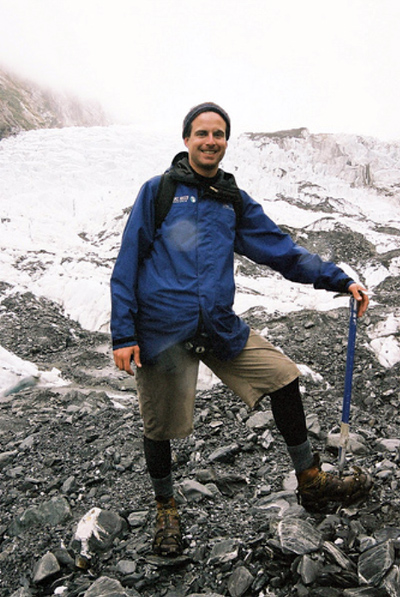The Pacific and Australian tectonic plates are colliding, flowing uphill, creating New Zealand and the Southern Alps, forming a cold wall that condenses the moisture out of the perpetual sub-Antarctic trade winds. The equivalent of nine meters of rain per year falls atop the Alps as wet snow. Franz Josef glacier is one of the fastest moving glaciers in the world, spilling out of the glacier’s basin at 2.5 meters per day. I think, “I only have centimeters to spare should the glacier suddenly shift.”

(Click for “FALLING UPHILL” GALLERY)
I pause. My crampons plugged into the glacier, the electric cold flowing up my legs, seizing my knees. I watch the grey sky roll past the seracs. I’m reminded of Everest’s Khumbu Icefalls— the most treacherous section of the ascent to the summit — and Goran Kropp. I met Goran in San Francisco and he told me he’s the only man to summit Everest beginning from sea level, in addition without using bottled oxygen or the Sherpa’s assistance. He bicycled from Stockholm, Sweden, (at sea level) to Nepal where he began a long trek by foot through the Himalayas to Base Camp, carrying two backpacks, and sometimes only able to carry only one pack up the mountain and having to return to the bottom for the second. This was during the famous disaster in 1996 that Jon Krakauer detailed in “Into Thin Air.” Nine people died; one of them was Goran’s close friend, another man named Scott. Nonetheless, the next day the song of the mountain lured Goran past the bodies of his friend and acquaintances to the summit of Everest.
“C’mon, Scott. You don’t have time to reminisce.” I inhale deeply, expanding my lungs, as if I can use the sky to wedge open the crevasse — or is it my spirit? After a moment, I slide one foot forward but my jacket is frozen to the glacier. Leaning sideways, my jacket pops loose; suddenly, as if the walls are buttered, I begin falling. I am barely able to reposition my heavy boot and crampon to prevent wedging myself in the bottom of the crevasse where it would’ve been nearly impossible to get my feet underneath me. I would’ve been trapped like a rabbit in a three-walled cage. (Rabbits can’t walk backwards.)
Goran told me he intended to quit mountain climbing. “It is not good for the head,” he said referring to the lack of oxygen. But the call of the wild was too strong and he was killed several years later in a mountain climbing accident, during a “moderately difficult” ascent, which seemed to me an anticlimactic end to his adventures. I’m sure he could have done so much more. I admired Goran’s contagious enthusiasm, charisma and accomplishments; in fact, after I met him and explained my dreams, I knew I could do it. But was Goran caught in a psychological three-walled box? Or, like a fish unaware of the ocean of possibilities? Did Goran die for the sake of exploration, to expand the frontiers of humanity? Or was he simply a thrill-seeker, an adrenaline junkie? What’s the difference between an explorer, adventurer, traveler and tourist?
continued on next page. . .






